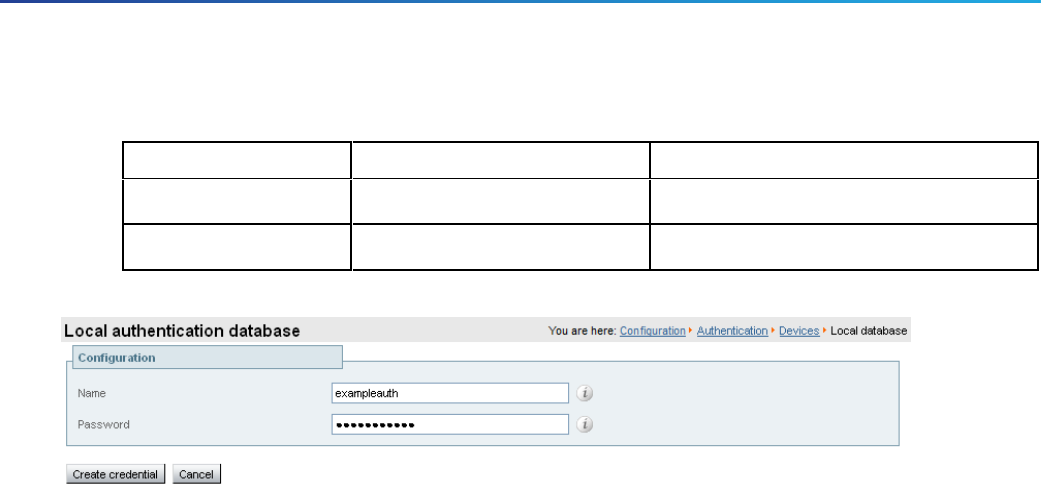Manual
Table Of Contents
- Preface
- Introduction
- Process Summary
- Prerequisites
- Run the Service Setup Wizard
- VCS System Configuration
- Routing Configuration
- Pre-search Transforms
- Search Rules
- Task 8: Configuring Transforms
- Task 9: Configuring Local Zone Search Rules
- Task 10: Configuring the Traversal Zone
- Neighboring Between VCS Clusters
- Task 11: Configuring Traversal Zone Search Rules
- Task 12: Configuring the DNS Zone
- Task 13: Configuring DNS Zone Search Rules
- Task 14: Configuring External (Unknown) IP Address Routing
- Endpoint Registration
- System Checks
- Maintenance Routine
- Optional Configuration Tasks
- Appendix 1: Configuration Details
- Appendix 2: DNS Records
- Appendix 3: Firewall and NAT Settings
- Appendix 4: Advanced Network Deployments
- Obtaining Documentation and Submitting a Service Request
- Cisco Legal Information
- Cisco Trademark

3. Configure the fields as follows:
VCS Control VCS Expressway
Name Not applicable
Enter exampleauth
Password Not applicable
Enter ex4mpl3.c0m
4. Click Create credential.
Neighboring Between VCS Clusters
You can neighbor your local VCS (or VCS cluster) to a remote VCS cluster; this remote cluster could be a neighbor,
traversal client, or traversal server to your local VCS. In this case, when a call is received on your local VCS and is
passed via the relevant zone to the remote cluster, it will be routed to whichever peer in that neighboring cluster has
the lowest resource usage. That peer will then forward the call as appropriate to one of its:
■ locally registered endpoints (if the endpoint is registered to that peer)
■ peers (if the endpoint is registered to another peer in that cluster)
■ external zones (if the endpoint has been located elsewhere)
Lowest resource usage is determined by comparing the number of available traversal calls (maximum - current use)
on the peers, and choosing the peer with the highest number. Peers that are in maintenance mode are not
considered.
When configuring a connection to a remote cluster, you create a single zone and configure it with details of all the
peers in the cluster. Adding this information to the zone ensures that the call is passed to that cluster regardless of
the status of the individual peers.
You also need to enter the IP address of all peers in the remote cluster when the connection is via a neighbor or
traversal client zone. You do not do this for traversal server zones, as these connections are not configured by
specifying the remote system's IP address.
Note: Systems that are configured as peers must not also be configured as neighbors to each other, and vice versa.
Neighboring your clusters
To neighbor your local VCS (or VCS cluster) to a remote VCS cluster, you create a single zone to represent the cluster
and configure it with the details of all the peers in that cluster:
1. On your local VCS (or, if the local VCS is a cluster, on the primary peer), create a zone of the appropriate type.
This zone will represent the connection to the cluster.
2. In the Location section, enter the IP address or FQDN of each peer in the remote cluster in the Peer 1 to Peer
6 address fields.
Note that:
■ Ideally you should use FQDNs in these fields. Each FQDN must be different and must resolve to a single IP
address for each peer. With IPaddresses, you may not be able to use TLS verification, because many CAs will
not supply certificates to authenticate an IPaddress.
32
Cisco VCS Expressway and VCS Control - Basic Configuration Deployment Guide
Routing Configuration










